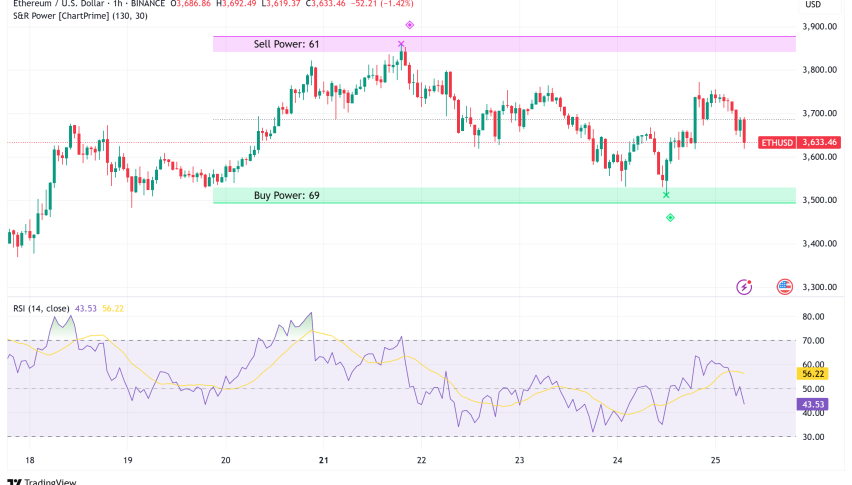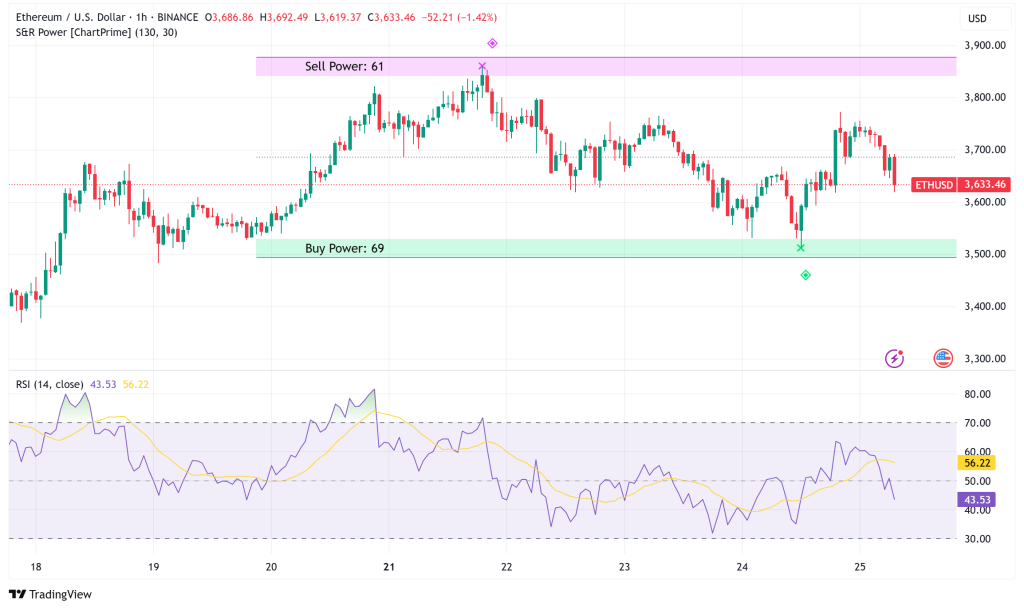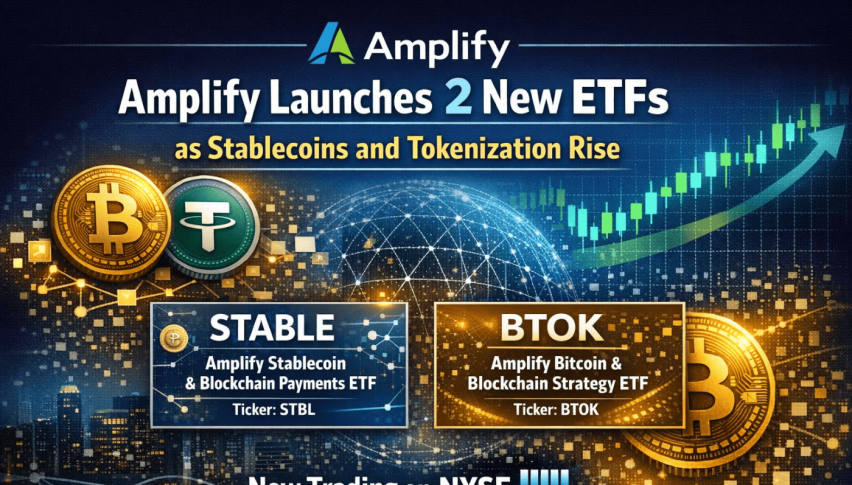Ethereum Faces Near-Term Headwinds Despite Strong ETF Momentum
Ethereum (ETH) is currently trading at around $3,647, which is above the important $3,600 support level. This is despite mixed indications

Quick overview
- Ethereum is currently trading at approximately $3,647, above the critical $3,600 support level, despite mixed technical signals.
- The surge in borrowing rates for wrapped Ether on platforms like Aave poses significant risks, potentially leading to unwinding in leveraged staking strategies.
- Institutional flows indicate a shift from Bitcoin to Ethereum, with Ether ETFs experiencing substantial inflows, suggesting a positive medium-term outlook.
- Concerns about MEV centralization and overbought technical conditions could lead to volatility in the near term, but historical trends suggest a stronger performance in Q4.
Ethereum ETH/USD is currently trading at around $3,647, which is above the important $3,600 support level. This is despite mixed indications from technical analysis and institutional flows. The second-largest cryptocurrency has shown amazing strength, with a 49% gain in the last 30 days. However, worries about borrowing costs and MEV centralization are making things harder for the short term.

Borrowing Rate Surge Creates Unwinding Pressure
The biggest danger to the price stability of Ethereum right now is the skyrocketing borrowing prices for wrapped Ether (wETH) on decentralized finance platforms. Markus Thielen, the head of 10x Research, says that the borrowing rate on the loan platform Aave has gone up from 86% to 95% since July 8. This makes it impossible to borrow money.
Thielen said, “The variable cost of borrowing wETH has gone up, and it’s not worth it to borrow ETH right now, so there should be more unwinding of those who have borrowed ETH on Aave.” This tendency has a big effect on leveraged staking tactics, or “looping,” which depend on low borrowing rates and steady stETH-to-ETH peg ratios to make money.
More than 90% of Ether loans have variable interest rates, which means that borrowers are at risk of abrupt cost spikes. Thielen says that if these yield-farming tactics stop making money, it might lead to what he calls “meaningful unwinding,” which could have “ripple effects across the Ethereum ecosystem.”
Technical Indicators Flash Overbought Warnings
From a technical point of view, Ethereum seems weak in the immediate run. The ETH/BTC ratio has gone up 34% in the last month, reaching 0.03116. This means that Ethereum has done far better than Bitcoin BTC/USD. Thielen’s analysis says that this quick rise has made technical indicators “deeply overbought.”
The timing is also worrying because the bitcoin market usually slows down in the summer, especially in August. This time of year is poor, and the technical conditions are too stretched, which makes corrections more likely to happen.
Institutional Capital Rotation Favors Ethereum
Institutional flows, on the other hand, tell a different tale. According to Swissblock analysis, money is moving from Bitcoin to Ethereum, and spot ETF flows are a crucial sign of this. Ether ETFs have had their biggest steady inflows since they started, with daily net inflows often going above $500 million.
This is very different from Bitcoin ETFs, which saw outflows of over $285 million over three days in a row. The difference shows that institutional investors are getting ready for Ethereum to take the lead in the next phase of the crypto cycle.
Swissblock said, “This isn’t just about price; it’s about how capital behaves.” “Demand for ETFs backs up what we’re seeing in momentum and structure: ETH is becoming the leader as the next part of the cycle starts.”
MEV Centralization Poses Long-Term Risks
New research shows that Ethereum’s Maximal Extractable Value (MEV) environment is becoming more centralized, in addition to the immediate pricing worries. A new research called “Measuring CEX-DEX Extracted Value and Searcher Profitability” says that three builders—beaverbuild, Titan, and rsync—are the most important in the Ethereum builder industry. Two of them even run their own CEX-DEX arbitrage operations.
This centralization has some worried about Ethereum’s decentralization and security, which could lead to monopoly pricing and make it easier for censorship attacks to happen. The concentration of MEV extraction could go against the network’s basic principles and make it less stable in the long run.
Ethereum Price Prediction and Outlook
Ethereum has a tough near-term prognosis because of the current technical and fundamental situation. There is a chance that it will be very volatile. The fact that borrowing costs are high, technical conditions are overbought, and the market is weak in the winter all point to a risk of going down in the next several weeks.
But looking at past patterns, there is cause to be hopeful beyond September. Since 2013, Q3 has been Ethereum’s second-worst quarter, with an average return of only 8.19%. On the other hand, Q4 usually does well, with an average return of 22.59%.
The fact that ETFs are moving from one institution to another, along with Ethereum’s stronger position compared to Bitcoin, implies that the medium-term outlook is still good. Ethereum might end 2025 on a high note if the current borrowing pressure goes down and technical indicators reset to healthier levels.
Traders and investors need to be careful in the short term, but they should keep a positive long-term outlook. The $3,600 level is an important level of support, and if it stays below that level for a long time, it might start the unwinding scenario that experts are keeping a close eye on.
- Check out our free forex signals
- Follow the top economic events on FX Leaders economic calendar
- Trade better, discover more Forex Trading Strategies
- Open a FREE Trading Account


